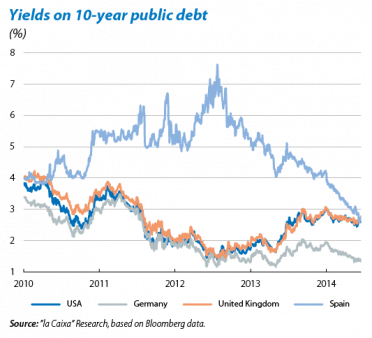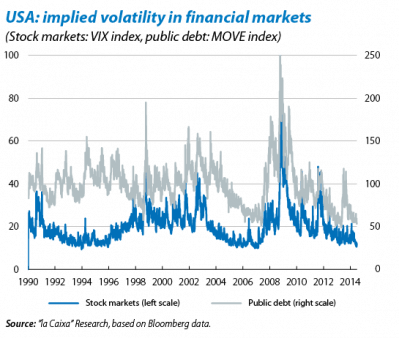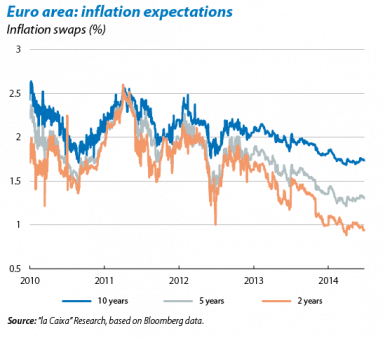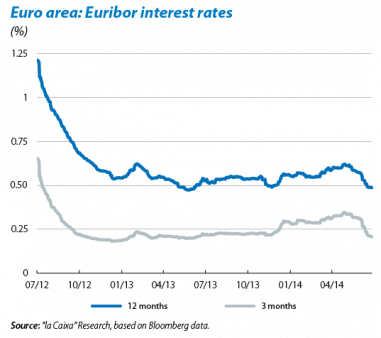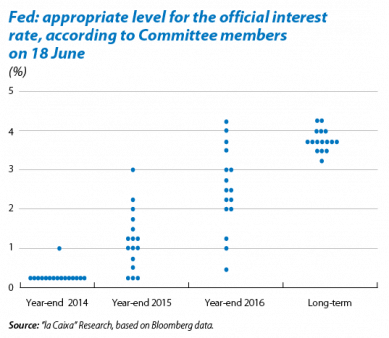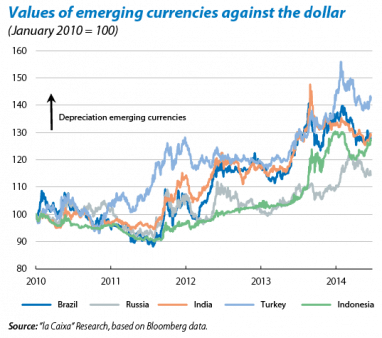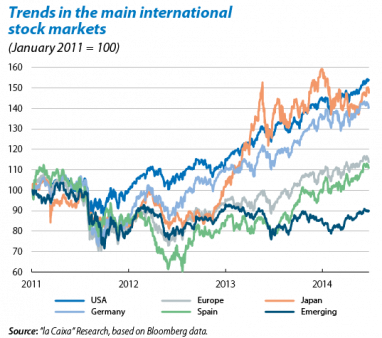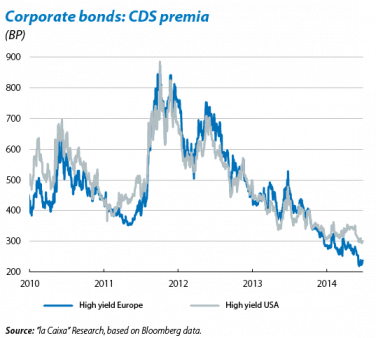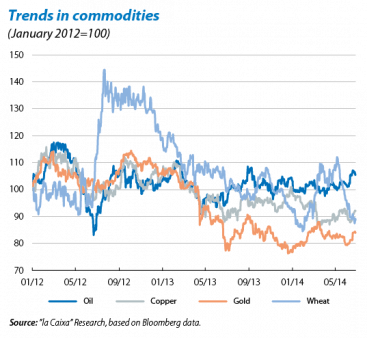The combination of good economic growth figures with the ultra-expansionary actions or messages of central banks has once again had a strong impact on the markets. The Fed has repeated its dovish message and insists that monetary normalisation will be slow. For its part, the ECB has adopted an ambitious package of measures to underpin growth in
the euro area and allay the threat of deflation. Investors have reacted unequivocally: risk-free interest rates and yields have remained at low levels (US) or have even entered negative terrain (Germany); risk premia on corporate bonds, periphery and emerging sovereign debt have narrowed and the stock markets have reached new all-time highs in some indexes. Volatility is at a very low level in all asset categories. One of the keystones to this situation is the increased appetite for risk among investors. However, the accommodative tone of central banks might be exacerbating the degree of complacency regarding risk, helping to overheat share prices and/or investors to enter into unsustainable debt.
The ECB has softened its policy. The bank more than met the expectations, at its June meeting deciding to implement an extensive and ambitious package of expansionary measures (see the Focus «The ECB makes a move»). Particularly important is the cut to the official interest rate down to 0.15% and in the deposit facility interest rate to –0.10%, as well as providing banks with very long-term financing on the condition they grant new loans (TLTROs). These actions are justified by the following reasons: (i) the appropriateness of relaxing monetary conditions (short-term interest rates and the value of the euro), (ii) the need to revive bank credit, and (iii) the aim of combating the risk of deflation. These actions might help the economic situation to improve gradually and inflation to rise. However, Draghi insisted that the ECB was prepared to extend stimuli even further if necessary. He announced that the bank is carrying out preparatory work for a possible ABS purchase programme (securitisation, possibly bank loans to SMEs). The debate on whether this would be advisable or feasible is intense. The ECB President has insinuated that such a tool will only be used if new loans and inflation expectations do not start to rise. For the moment, the reaction of the money markets has been immediate, especially with the EONIA and Euribor rates falling to minimal levels. There has also been a drop in yields in the debt markets. The euro's exchange rate has lost ground against the dollar but not much: it is still around 1.36 dollars.
The Federal Reserve is taking its time. The meeting of the FOMC did not arouse as much expectation as that of the ECB although it could end up having more impact on markets in the medium term. The tone was clearly dovish. It is true that, as expected, the Fed agreed another step in tapering, reducing its monthly bond purchases by a further 10 billion dollars (now standing at 35 billion). But the rest of the meeting's content was accommodative. In fact, more information was expected on the roadmap for monetary normalisation but the Chairman, Janet Yellen, chose not to go into too much detail although she did try to convey the message that the institution is in no hurry to turn its strategy around. She insinuated that, once tapering has finished (at the end of year), the bonds maturing will be reinvested, thereby maintaining the size of the Fed's balance sheet. Regarding official interest rates, the plan is to keep them at very low levels for a prolonged period of time. The forward guidance is ambiguous at present. Fed members agree as to when interest rate hikes should start (mid-2015) and the long-term equilibrium level (3.75%) but there is a lot of disagreement regarding how far they should rise: for some the appropriate level at the end of 2016 should be 3.75%, while for others it is just 1%. Yellen came down on the side of the slow rate. The markets reacted with gratitude: stability in Treasuries and gains in the S&P 500. But all the evidence suggests that the debate regarding monetary normalisation will continue to be lively and might lead to more volatility than seen at present.
The emerging countries are heading in the right direction but at different speeds. The overall diagnosis for these countries continues to improve. Within the context of low volatility dominating international financial markets, capital inflows to emerging markets are starting to recover after the outflows suffered between May 2013 and the beginning of this year. Two points stand out in this movement: (i) the solid cyclical indicators for China, supported by the positive effect of fiscal and monetary stimuli, and (ii) the albeit modest progress being made in correcting imbalances in Asian countries. The other side of the coin is provided by countries such as Brazil and Turkey whose economies are still under too much inflationary pressure.
Easy monetary conditions are affecting the US bond market. The stability of Treasury yields is still the predominant tone, within a scenario of little volatility. Given this situation, investors appear to have paid more attention to the dovish tone of the Fed Chairman than the debate raging among its members regarding the right interest rate level for the coming years. Confirmation of the setback in GDP at the start of the year and the slow recovery in household consumption also affected the mood of agents throughout June. However, if economic activity continues to grow, as expected, and the labour market goes on improving, given the first signs of inflation picking up we expect the next few months to witness an increase in interest rates throughout all tranches of the curve.
Europe's sovereign debt yields have fallen again. The measures adopted by the ECB and the Fed's stance have been sufficient to intensify investors' search for yield. This helped to push down the yield on the German 10-year bund to 1.25% at the end of June. With regard to the periphery, their performance has been good but the rally of the last few quarters appears to be flagging. Spain's sovereign debt risk premium has fluctuated around 135 basis points, a level that seems to be in line with the fundamental variables. In the medium term, the measures implemented by the ECB are likely to favour periphery debt more than that of the core countries. In Spain, the Treasury ended the first half of the year with a positive balance, having covered 57% of all gross issuances planned for the year.
Equity is on the up. The increased appetite for risk, reinforced by very low volatility, means that international stock markets are booming. Indexes such as the S&P 500 and DAX, where there are still some signs of over-buying, have set new records. Several factors have helped to produce these gains such as easy monetary conditions, larger flows of capital towards equity, the capacity of multiples to expand (higher in the stock market than the bond market) and the upswing in global mergers and acquisitions. In Spain, the Ibex 35 was above 11,000 points for a large part of June's sessions, thanks to the consolidation of growth and the ECB's announcements. However, several aspects can be observed in the current environment that might threaten these booming stock markets: high share price ratios in the US stock market, exuberant sentiment indicators and the fact that investors are likely to become complacent. Neither should we ignore the risks resulting from the conflict between Russia and the Ukraine or the recent tensions in Iraq with their consequences for oil prices. The stock markets of the emerging countries have continued to see gains over the last few weeks and the stabilisation of the risk premia for their economies and liquidity provided by the developed monetary authorities have led to foreign capital returning.
Corporate bonds are making the most of the current situation. The actions taken by central banks are crucial for the development of capital markets and specifically corporate bonds. The latest actions in the monetary area are contributing even further to the narrowing of spreads for bonds of companies in developed countries. In Europe, apart from senior corporate debt, 2014 is being a good year for the primary market. The total volume of bonds issued in the first six months is close to 800 billion euros, 12% up on the same period last year. Hybrid and high yield bonds, together with the subordinated debt of financial institutions, are meeting the rising demand for high risk and high yield products. Over-activity in these segments of the bond market is coming close to its level before the financial crisis. This has set alarm bells ringing regarding the possible formation of credit bubbles in some sectors and the irrational nature of some issuances within a context where guarantees for bond holders have been reduced.
